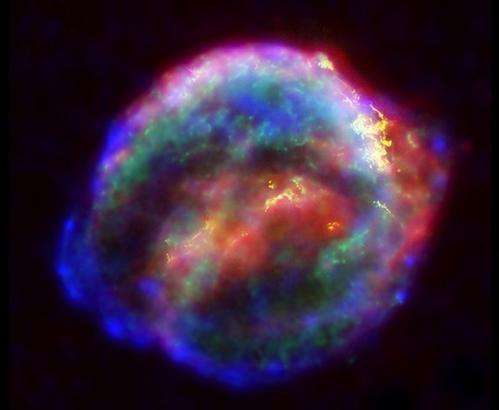Kepler's supernovae

(Phys.org)—Supernovae, the explosive deaths of massive stars, are among the most momentous events in the cosmos because they disburse into space all of the chemical elements that were produced inside their progenitor stars, including the elements essential for making planets and life. One class of supernovae (type Ia) provide yet another benefit: they are considered to be standard distance candles, and are used by astronomers to estimate the distances to remote galaxies whose supernovae appear faint because they are far away; thus they can calibrate the cosmic distance scale.
In October of 1604, a supernova went off in our Milky Way galaxy in the direction of the constellation of Ophiuchus. It was so bright that it was visible in the daytime for three weeks. Johannes Kepler began observing it after about the first week, and he subsequently wrote a book about it. Since then, no other supernova has been seen in our galaxy, though many others have been spotted elsewhere. Kepler's supernova (as it is sometimes called) happens to be a Type Ia supernova, and because of its proximity it is an important linchpin in calibrating standard distance candles. Ironically, the precise distance to the remnant of Kepler's supernova is not very well known. It has been variously estimated over the years as between about fifteen and twenty-one thousand light-years (from the amount of gas seen between the remnant and Earth) or maybe only ten thousand light-years (from the remnant's motion with other stars in the galaxy).
CfA astronomer Daniel Patnaude and three of his colleagues have now taken an important step in determining the distance more accurately. They note that Kepler's supernova remnant has another feature: unlike most other Type 1a remnants, Kepler's shows clear signs that the explosive blastwave encountered a dense circumstellar shell.
The scientists used the Chandra X-ray Observatory to observe the spectral emission from iron atoms in the hot gas, and modeled it as arising from the supernova ejecta and shocked material. They conclude from measurements of the size, strength, and details of the emission that the remnant distance is probably greater than about twenty-one thousand light-years, although additional research is needed to strengthen this conclusions. After 407 years of scientific inquiry, the new results finally help bring closure to our understanding of this dramatic spectacle.
Provided by Harvard-Smithsonian Center for Astrophysics





















